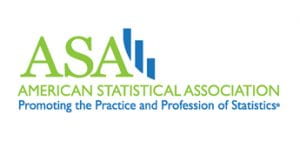 Katherine (Kathy) B. Ensor
Katherine (Kathy) B. Ensor
It is an exhilarating and dynamic time to be a statistician and I am honored to be the President of the American Statistical Association. As we move into an era where data are the new gold, our professions’ skills, talents, intellect and energy become increasingly important. We are now able to fully capitalize on our strong foundations in the age of ubiquitous data and extensive computational resources, both hardware and software. We live and breathe this excitement in our daily lives, passing this enthusiasm along to the next generation of statisticians and data scientists. I look forward to ensuring ASA embraces your professional needs in this new world of data.
Areas for ASA’s immediate attention are leadership, advancing ASA’s data science footprint, and engaging in the new frontier of urban analytics and the changing landscape of data privacy and use.
Leadership: Our profession can point to members who hold strategic leadership positions across industry, government and academia. Why? Training in statistics naturally develops a foundation for leadership in large part due to the interdisciplinary structure of our profession. Further, many of the core issues of leadership are also core to our profession, such as ethically based decisions. But leadership requires training and development. In 2018, ASA founded the Leadership Institute and it needs to be enhanced, not forgotten. What additional opportunities are there to provide further programming to ASA members and elevate our voices to the strategic table?
Attention to leadership also extends to ASA as an organization. The ASA Board issues policy statements on matters of national importance related to data and statistics. This is a great start but we need to further expand ASA’s influence to the top levels of academia and industry to have a positive impact on our profession, and our profession’s ability to bring statistical science forward to meet today’s opportunities and challenges.
Data Science: Our field has seen an explosion of new methods in statistics and data science, integrating the best of statistical thinking and practice. Forward-looking universities rely heavily on, and invest in, their statistics departments to build top data science programs. ASA has an opportunity to work with university leaders to articulate the value statisticians bring to their strategic leadership table. Many universities are developing institutes and schools around data science, providing clear opportunities for leadership from statisticians.
The ASA Ad Hoc Committee on Data Science I co-lead is charged with advising the ASA board on actions around data science. I look forward to furthering the effort of this exemplary committee.
Community Analytics and the Changing Landscape of Data: The time is now for statisticians to jump into the growing area of community analytics. Community analytics, both urban and rural, requires the best of our statistical thinking coupled with a willingness to engage local governments, NGOs, and communities to improve our quality of life. Environments generate massive amounts of geo-referenced data, allowing us to draw insights into how we work, live, play and learn within our communities. More needs to be done to leverage expert use of statistics in this area. Does urban analytics present an opportunity for greater involvement of local chapters with their communities? Can ASA help foster such collaborations?
Central to urban analytics are growing issues of data privacy and the changing landscape of availability and use of government-generated data. For example, to maintain constitutional confidentiality requirements, the 2020 U.S. Census tabulations will be adjusted using differentially private algorithms. The impact of this necessary change is not yet well understood. Further, the recent Foundations for Evidence-Based Policymaking Act, significantly changes what data will be available for research and what data can be used to inform government policy. These challenges provide an opportunity for ASA to take a leadership role ensuring our profession is partnering with relevant societies to understand the changes and expertly address their impact.
I look back in amazement at the changes in the profession since the beginning of my career as a statistician. With its mission of “Promoting the practice and profession of statistics,” the ASA is a first-class scientific organization. As President, I look forward to helping ASA continue to grow and develop as our profession grows and develops, contributing to ASA’s continued success.

